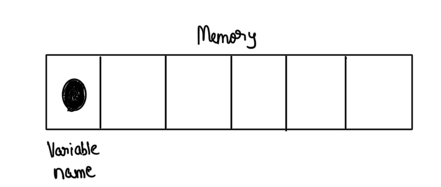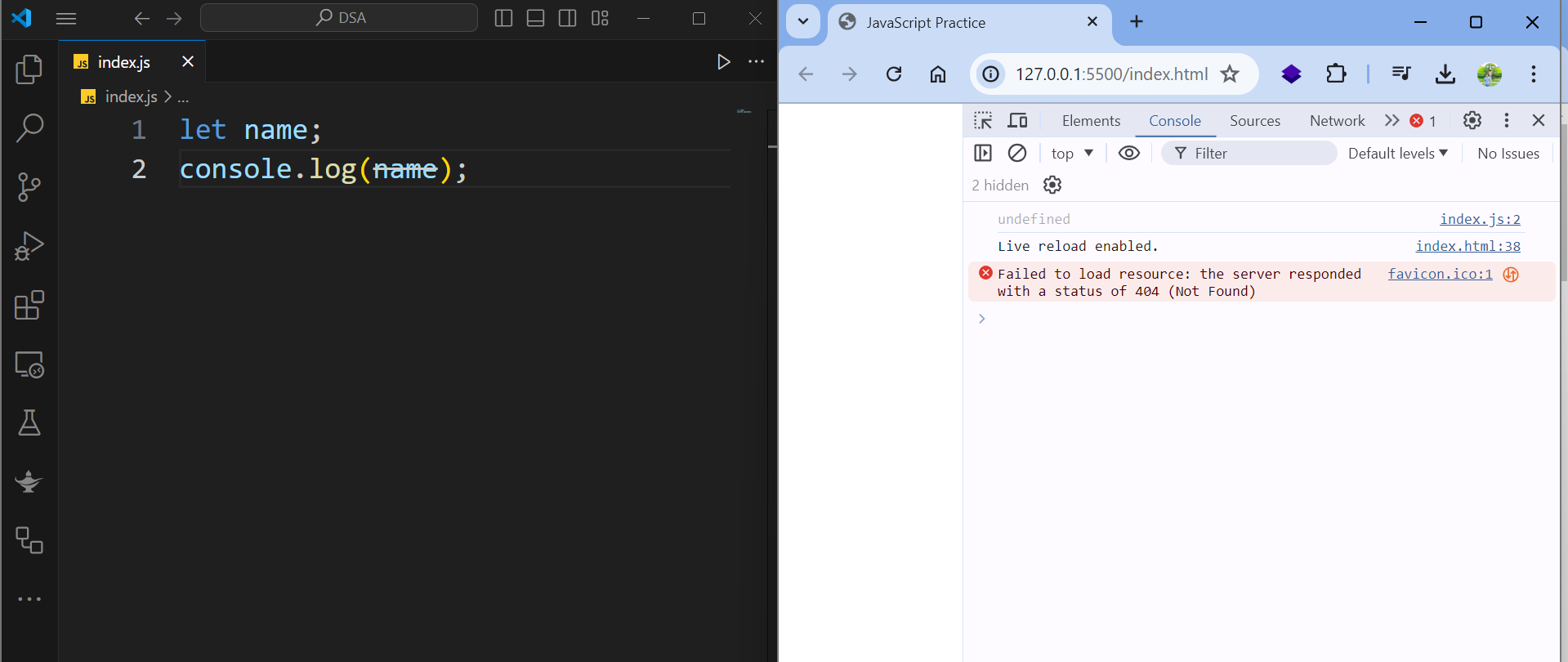Variables
- Let's start this section by a discussion of variables, which are one of the most fundamental concepts in JavaScript and any other programming languages.
In programming, we use a variable to store data temporarily in the computers memory.
-
So we store our data somewhere, and give that memory location a name.
-
And with this name, we can read the data at the given location in the future

-
Here's a metaphor for better example:
-
Think of the boxes you use to organize your stuff.
-
You put your stuff in various boxes, and put a label on each box.
-
With this, you can easily find your stuff. A variable is like a box.

-
-
What we put inside the box, is the value that we assign to a variable, that's the data, and the label that we put on the box is the name of our variable.
Now let's see this in code:
-
So here in
index.js, I'm going to declare a variable. -
Previously in the old days, before ES6, we used the
varkeyword to declare a variable. But there are issues withvaras you will find out later in the course. (Note that name is the variable name, we will be studying in the next lecture about the naming conventions for variable name)
var name;
- So, going forward from ES6, the best practice is to use the
letkeyword to declare a variable.
let
-
Now, we need to give this variable a name, or an identifier, and this is like the label we put on a box.
-
So I'm going to call this variable a
name, and finally we need to terminate this declaration with a semi colon.
let name;
- Now let's log this on the console and see what we get.
let name;
console.log(name);
- Save the changes, and here in the console we see undefined.

-
So by default, variables that we defined in JavaScript, their value is undefined.
-
Now we can optionally initialize this variable. So I'm going to set this to be a string, like
Pratham
String is a sequence of characters.
let name = 'Pratham';
console.log(name);
-
Note that I'm using single quotes, we can also use double quotes, different developers have different purposes, but it's more common to use single quotes for declaring strings, in JavaScript.
-
When you save the changes, you will see that instead of undefined, we see
Prathamon the console.
Rules for naming the variable in JS:
-
Now, we have a few rules for naming these variables. here are the rules:
-
first is that they cannot be a reserved keyword, so in Javascript, we have reserved keywords like:
-
let
-
if
-
var, and so on the list continues
-
-
now you don't have to memorize this list, if you try to use one of these above names, you're going to get an error. For example:

-
if I change
nametoifreserved keyword, I will get an error indicating that this is not a valid identifier -
The second rule is that variable names should be meaningful.
-
like meaningful labels. I've seen developers using names like
aorbora1orx. -
These variable names don't give us any clue what is the purpose of these variables and what kind of data are we storing in that memory location
-
So always use meaningful and descriptive names.
-
-
The third rule is that they cannot start on a number.
- So we cannot have a variable like
1name, it will print an error. Also these names are meaningless. Always use meaningful names.
- So we cannot have a variable like
-
The fourth rule is that they cannot contain a space or hyphen
-
So if you have multiple words we need to put them together
-
Here is an example, let's imagine we want to declare a variable called first name.
let firstName; // Camel Case Notation-
Note that here I'm using camel notation, so the first letter of the first word should be lowercase, and the first letter of every word after should be upper case. This is known as CAMEL NOTATION.
-
This is the convention used in JavaScript to name our variables.
-
-
Another thing you need to know about these variable names, is that they are case-sensitive.
- so if I declare another variable, call it first name, but make the f upper case this time.
let firstName; // Camel Notation let FirstName;- Note that these two variables are different, and they are not same. They are case-sensitive.
-
Multiple Declaration and Initialization of variables:
-
Finally the last thing you need to know about these variables, is that if you want to declare multiple variables, there are two ways to do this.
-
You can declare them on one line and separate them using a comma:
let firstName, lastName;
-
For example, as you can see above, the first name and then the last name separated with the comma. Now in this case, I have not initialized either of these
variables, they're both undefined, I can optionally initialize 1 or both of them.
-
So
firstNamewould bePrathamandlastNamewould beMehta. I can also leave lastName undefined, but the modern best practice is to declare each variableon a single line (method 2).
let firstName = 'Pratham', lastName = 'Mehta';
console.log(firstName + ' ' + lastName);
- Later on we will discuss about String contatenation in JavaScript and how can we format the string literals.
- Another way for intialization and declaration is like this:
let firstName = 'Pratham';
let lastName = 'Mehta';
console.log(firstName + ' ' + lastName);
Summary of the code for this lecture:
let name = 'Pratham';
console.log(name);
// Rule 1 : Variable names cannot be a reserved keyword
/*
let if = 'Pratham';
console.log(if); // Syntax Error
*/
// Rule 2 : Variable names should be meaningful
// Rule 3 : Variable names cannot start with a number (1name)
// Rule 4 : Variable names cannot contain a space or hyphen (-)
// Rule 5 : Variable names are case-sensitive
let firstName = 'Pratham'; // Camel Case notation
let FirstName; // Pascal Case notation
//Multiple declaration and Intialization
// Method 1
let firstName = 'Pratham', lastName = 'Mehta';
console.log(firstName + ' ' + lastName);
//Method 2
let firstName = 'Pratham';
let lastName = 'Mehta';
console.log(firstName + ' ' + lastName);
Next we're going to look at constants.